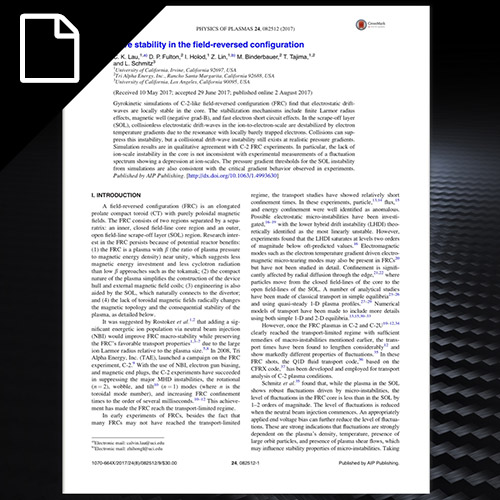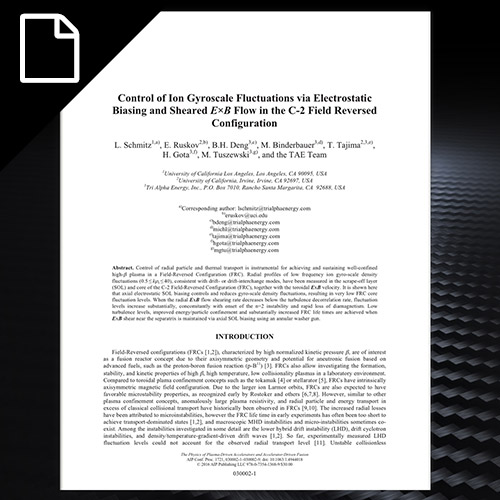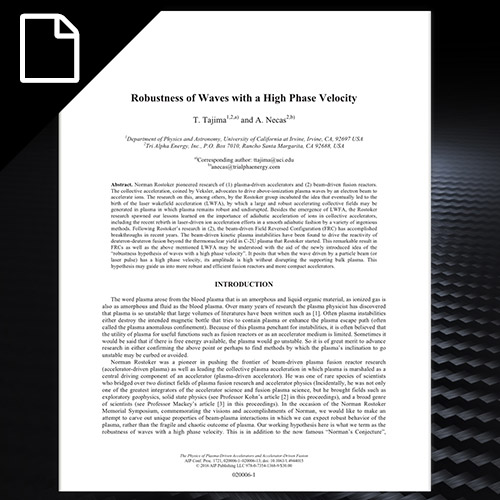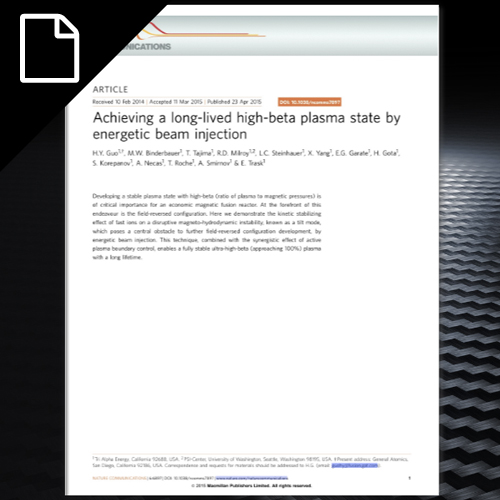
Aug 2017 | Research Library, Papers, Equilibrium, Fusion Energy, Fusion Research, Fusion Science, Fusion Technology, Simulation, Stability, Theory, Turbulence, Waves
August 2017 | C. K. Lau | Physics of Plasmas | Paper
Gyrokinetic simulations of C-2-like field-reversed configuration (FRC) find that electrostatic drift- waves are locally stable in the core. The stabilization mechanisms include finite Larmor radius effects, magnetic well (negative grad-B), and fast electron short circuit effects.

Dec 2016 | Research Library, Papers, Diagnostics, Edge Control, Experiment, Fusion Energy, Fusion Research, Fusion Science, Fusion Technology, Stability, Transport, Turbulence
December 2016 | L. Schmitz | Nature Communications | Paper
An economic magnetic fusion reactor favours a high ratio of plasma kinetic pressure to magnetic pressure in a well-confined, hot plasma with low thermal losses across the confining magnetic field.

Jun 2016 | Research Library, Papers, Fusion Energy, Fusion Research, Fusion Science, Fusion Technology, Plasma Research, Simulation, Stability
June 2016 | Niko Rath | AIP Publishing | Paper
We show that in a field-reversed-configuration, the plasma is unstable to either transverse or axial rigid displacement, but never to both.

Mar 2016 | Research Library, Papers, Diagnostics, Edge Control, Experiment, Fusion Energy, Fusion Research, Fusion Science, Fusion Technology, Stability, Transport, Turbulence
March 2016 | L. Schmitz | AIP Conference Proceedings | Paper
Control of radial particle and thermal transport is instrumental for achieving and sustaining well-confined high-β plasma in a Field-Reversed Configuration (FRC). Radial profiles of low frequency ion gyro-scale density fluctuations (0.5 ≤ kρs ≤ 40), consistent with drift- or drift-interchange modes, have been measured in the scrape-off layer (SOL) and core of the C-2 Field-Reversed Configuration (FRC), together with the toroidal ExB velocity.

Mar 2016 | Research Library, Papers, Fusion Energy, Fusion Research, Fusion Science, Fusion Technology, Modeling, Stability, Theory, Transport, Waves
March 2016 | T. Tajima | AIP Conference Proceedings | Paper
Norman Rostoker pioneered research of (1) plasma-driven accelerators and (2) beam-driven fusion reactors. The collective acceleration, coined by Veksler, advocates to drive above-ionization plasma waves by an electron beam to accelerate ions. The research on this, among others, by the Rostoker group incubated the idea that eventually led to the birth of the laser wakefield acceleration (LWFA), by which a large and robust accelerating collective fields may be generated in plasma in which plasma remains robust and undisrupted.

Apr 2015 | Papers, Featured Publications, Fusion Energy, Fusion Research, Fusion Science, Fusion Technology, Plasma Research, Research Library, Stability, Top Level
April 2015 | H. Guo | Nature Communications | Paper
Developing a stable plasma state with high-beta (ratio of plasma to magnetic pressures) is of critical importance for an economic magnetic fusion reactor.




